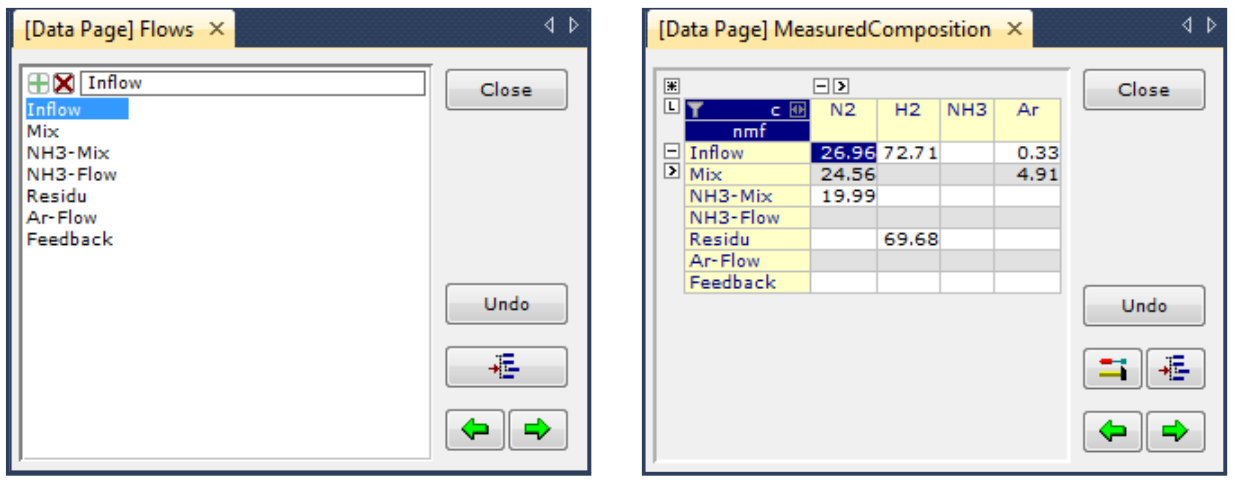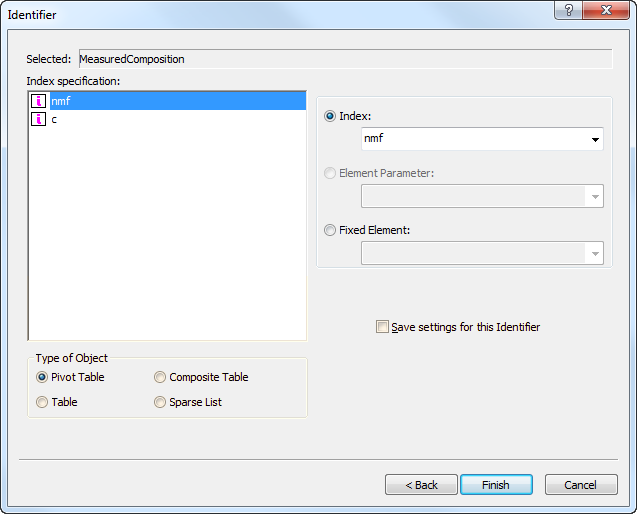Viewing and modifying identifier data
Viewing identifier data
When you are developing your model (or are reviewing certain aspects of it later on), AIMMS offers facilities to directly view (and modify) the data associated with a particular identifier. This feature is very convenient when you want to enter data for an identifier during the development of your model, or when you are debugging your model (see also The AIMMS debugger) and want to look at the results of executing a particular procedure or evaluating a particular identifier definition.
The Data button
Via the Data button  available in the attribute window of
every global identifier (see, for instance,
Fig. 18), AIMMS will pop up one of the data pages
as illustrated in Fig. 22.
available in the attribute window of
every global identifier (see, for instance,
Fig. 18), AIMMS will pop up one of the data pages
as illustrated in Fig. 22.

Fig. 22 Data pages of a set and a 2-dimensional parameter
Data pages provide a view of the current contents of the selected identifier. Which type of data page is shown by AIMMS depends on the type of the identifier. The data page on the left is particular to one-dimensional root sets, while the data page on the right is appropriate for a two-dimensional parameter.
Data pages for variables and constraints
For variables (and similarly for constraints), AIMMS will display a pivot table containing all the indices from the index domain of the variable plus one additional dimension containing all the suffices of the variable that contain relevant information regarding the solution of the variable. Depending on the properties set for the variable, this dimension may contain a varying number of suffices containing sensitivity data related to the variable.
Viewing data in the Model Explorer
Data pages can also be opened directly for a selected identifier node in the model tree using either the Edit-Data menu, or the Data command in the right-mouse pop-up menu. Additionally, you can open a data page for any identifier referenced in an attribute window by selecting the identifier in the text, and applying the Data command from the right-mouse pop-up menu.
Multidimensional identifiers
For multidimensional identifiers, AIMMS displays data using a default
view which depends on the identifier dimension. Using the  button on the data page you can modify this default view. As a result,
AIMMS will display the dialog box illustrated in
Fig. 23.
button on the data page you can modify this default view. As a result,
AIMMS will display the dialog box illustrated in
Fig. 23.

Fig. 23 Selecting a data page type
In this dialog box, you can select whether you want to view the data in a sparse list object, a composite table object, a pivot table object or in the form of a (rectangular) table. Additionally, you can indicate that you want the view to be sliced, by selecting fixed elements for one or more dimensions. For every sliced dimension, AIMMS will automatically add a floating index to the data page, allowing you to view the data for every element in the sliced dimension.
Saving your choice
If you want to always use the same data page settings for a particular identifier, you can save the choices you made in Fig. 23. As a result, AIMMS will save the data page as an ordinary end-user page in the special All Data Pages section of the Page Manager. If you so desire, you can further edit this page, and, for instance, add additional related identifiers to it which will subsequently become visible when you view the identifier data in the Model Explorer.
End-user page as data page
Whenever there is a page in the All Data Pages section of the page
manager with the fixed name format [Data Page] followed by the name
of an identifier of your model, AIMMS will use this page as the data
page for that identifier. This enables you to copy a custom end-user
page, that you want to use as a data page for one or more identifiers,
to the All Data Pages section of the page manager, and rename it in
the prescribed name format. When you remove a page from the All Data
Pages section, AIMMS will again open a default data page for that
identifier. If you hold down the Shift key while opening a data
page, AIMMS will always use the default data page.
Global and local identifiers
Normally, AIMMS will only allow you to open data pages of global identifiers of your model. However, within the AIMMS debugger (see also The AIMMS debugger), AIMMS also supports data pages for local identifiers within a (debugged) procedure, enabling you to examine the contents of local identifiers during a debug session.